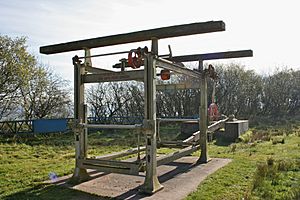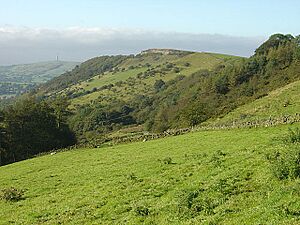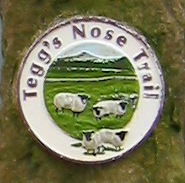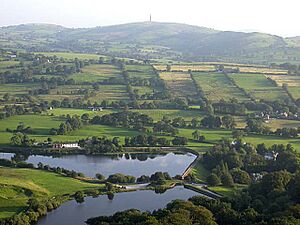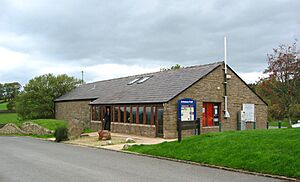Tegg's Nose facts for kids
Quick facts for kids Tegg's Nose |
|
|---|---|

Tegg's Nose from Ridgegate Reservoir
|
|
| Highest point | |
| Elevation | 380 m (1,250 ft) |
| Geography | |
| Location | Cheshire, England |
| Parent range | Peak District |
| OS grid | SJ947725 |
| Topo map | OS Outdoor Leisure 24 |
Tegg's Nose is a famous hill located east of Macclesfield in Cheshire, England. It has a short ridge that reaches 380 metres (1,246 feet) at its highest point. The hill ends in a rocky point at its southern side. Tegg's Nose sits on the western edge of the Peak District, but it is not inside the national park itself. A large part of the hill is known as Tegg's Nose Country Park. This park is looked after by the Cheshire East Council Countryside Management Service. Tegg's Nose is also part of a special program called the Environmentally Sensitive Area Scheme.
In the past, people dug for stone here. Today, Tegg's Nose has many different natural areas. These include open moorland, green meadows, farmland, and forests with broadleaved trees. It is also home to lots of different plants and animals. Many people visit the area for fun activities. You can go walking, orienteering, horse riding, fell running, cycling, mountain biking, rock climbing, sledging, and fishing.
Contents
The Story of Tegg's Nose
The name "Tegg's Nose" has an interesting history. It was first called "Tegge's Naze." "Tegge" might have been the name of an early Norse settler, or it could refer to a sheep. The "nose" part likely describes the rocky point at the southern end of the hill.
People believe that humans lived in this area a very long time ago, during the Bronze Age. There is even a Bronze Age burial mound, called a barrow, near High Low Farm, south of Tegg's Nose. After the Norman Conquest, the hill became part of the Royal Forest of Macclesfield. This was a special hunting area owned by the Earls of Chester.
Digging for Stone: The Quarries
From the 1500s until 1955, people dug for a type of stone called millstone grit at Tegg's Nose. There were two main places where they dug. One quarry was near the northern viewpoint, called Windyway. This quarry produced a blue stone. The other quarry was closer to the Tegg's Nose summit and produced "Tegg's Nose Pink" stone.
At first, workers dug the stone by hand. This created very high-quality stone. It was used to build houses, make gravestones, and create kerbs, flagstones, and cobbles. This stone was even sent as far away as the Isle of Man.
In the 1930s, they started using explosives to blast the stone. This produced crushed stone for roads and airfields. During the Second World War, they used pneumatic drills to get rock for airport runways. Today, you can still see some of the old quarrying machines in the Country Park. These include a jaw crusher, a crane, and a stone saw. The saw was once powered by a steam engine. You can also see signs of an old railway track around the disused quarry at the top of the hill. There is even evidence of a bomb crater at the bottom of Tegg's Nose. This was caused by a German bomber during World War II and can be seen from the summit.
Water for Macclesfield
Two reservoirs, Bottoms and Teggsnose, were built in 1850 and 1871. These reservoirs helped control the flow of the River Bollin. This river was important for the textile mills in Macclesfield and Langley. These towns once had many silk mills that used water power. The nearby Ridgegate Reservoir was built around the same time to provide drinking water for Macclesfield. Later, Trentabank Reservoir was built in the 1920s.
Nature and Wildlife at Tegg's Nose
A large part of Tegg's Nose is a mix of open moorland and green meadows. The moorland is covered with plants like wood sage, heather, and bilberry. The meadows have many beautiful wild flowers. These include mountain pansy, tormentil, and harebell. At lower parts of the hill, you can find gorse, bramble, and hawthorn bushes.
The southern part of the hill is covered by Teggsnose Wood. This forest has broadleaved trees like oak, beech, hornbeam, holly, and mountain ash.
Birds and Animals
Many different birds live in the area. You might see woodpeckers, nuthatches, flycatchers, tree creepers, thrushes, tits, and warblers. Larger birds like buzzards and ravens also fly overhead. On the reservoirs, you can spot various waterfowl, including grebes and tufted ducks. In the summer, Angus Cross cattle from a farm in Langley graze in the fields.
At the bottom of the hill to the south are two smaller reservoirs. Bottoms Reservoir holds 34 million gallons of water, and Teggsnose Reservoir holds 24.5 million gallons. The Walker Barn stream flows into Teggsnose Reservoir.
Fun Things to Do at Tegg's Nose
The Tegg's Nose ridge has three great spots for views. On clear days, you can look west across the Cheshire Plain and see as far as Liverpool and the Welsh hills. To the east, you can see Macclesfield Forest and the unique hill called Shutlingsloe.
Walking and Hiking Trails
Many paths cross the area, including public footpaths and bridleways (paths for horses). The Tegg's Nose Trail is a circular path about 4 kilometres (2.5 miles) long. Part of this trail is also a bridleway. The path markers for this trail are round plaques that show the view towards Shutlingsloe.
Another circular trail is the "Walk to the Forest." This path is about 11 kilometres (6.8 miles) long and connects Tegg's Nose to the trees of Macclesfield Forest. Saddlers Way, which is part of both these trails, was once an old path used by packhorses. Tegg's Nose is also on the Gritstone Trail, a long-distance footpath. It marks the end of the northern part and the start of the central part of this trail. The Peak District Boundary Walk follows the same route through the country park. Tegg's Nose is also a good starting point if you want to climb Shutlingsloe through Macclesfield Forest.
Other Activities
Tegg's Nose is a popular place for orienteering, which is like a treasure hunt using a map and compass. Several permanent courses are available. The Tegg's Nose Fell Race, a running race up and down the hill, happens every August.
There are three cycling routes that start at Tegg's Nose. "Grit and Gears" is a 19-kilometre (12-mile) circular trail, partly off-road, great for mountain bikes. "Riding the Ridges" is a 28-kilometre (17-mile) circular route on smaller roads, with optional off-road parts. Regional Cycle Route 71 is a long-distance road route. The Cheshire Cycleway (route 70) also passes just south and east of the Country Park.
For those who enjoy a challenge, there are ten traditional climbing routes on the quarried gritstone. These routes range in difficulty. When it snows in winter, sledging is very popular, with special fields set aside for it. If you like to fish, you can go coarse fishing at Teggsnose and Bottoms Reservoirs. You might catch mirror and common carp or bream.
Visiting Tegg's Nose: What You Need to Know
At the northern viewpoint, there is a visitor centre located off Buxton Old Road. Here, you can find parking for cars and horse boxes, information about the area, public toilets, and picnic tables. There is even a telescope to help you see the views better. Since spring 2016, there has been a tea room open every day of the week.
Near the visitor centre, you will see several outdoor sculptures. These include a stone sheep, a bench shaped like an abstract tree, and carved wooden benches around the viewpoint. You can also park your car by Teggsnose Reservoir and at the Trentabank ranger station in Macclesfield Forest. If you're looking for a place to eat nearby, there are two pubs: the Leather's Smithy by Ridgegate Reservoir and the St Dunstan in the village of Langley.
You can reach Tegg's Nose by bus from Macclesfield or Buxton. It's important to know that wheelchair access is limited because of the uneven ground. Also, there are places with steep drops that are not fenced, so be careful. There are not many places to stay overnight very close to the hill.
Amazing Views from the Summit
The very top of Tegg's Nose offers a full 360-degree view. You can see the nearby town of Macclesfield and the wide Cheshire Plain stretching out before you.



